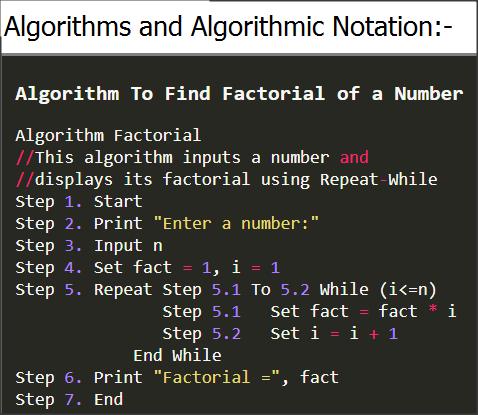Topic: Introduction to Algorithm and Algorithmic Notation With Examples
The step by step procedure to solve a particular problem is called an Algorithm. A Good Programmer always writes algorithms before developing programs.
Sponsored Links
An algorithm is the sequenc of steps to perform a task, whereas a program is the set of statements to perform a specific task. Normally, we will use a programming statement (instruction of a programming language) for each step of an algorithm.
For example, consider the following four steps of an algorithm of a program to find square of a number:
For example, we will use the following set of statements as algorithmic notation to design the algorithms:
Algorithm square.
For example:
// This algorithm is used to input a number and display its square.
// Compute square of the number n
square = n * n
We will use double slash // to start a single line comment.
For example:
Input a number in n.
Or more precisely
Input n
Input radius of circle in rad.
Note: rad is a variable to store the value of the radius of the circle.
Or more precisely,
Input rad
For example:
Print "Enter a number"
or
Print "Sum=",sum
i = 1
or
sum = num1 + num2
For example:
If (num1 == num2)
Print "both numbers are equal"
End If
If (num1 == num2)
Print "both numbers are equal"
Else
Print "numbers are different"
End If
Step 1. Repeat steps 1.1 For i = 1 to 5 step 1
Step 1.1 Print i
End For
What is an Algorithm?
The step by step procedure to solve a particular problem is called an Algorithm. A Good Programmer always writes algorithms before developing programs.
 |
| Algorithmic Notation with example algorithms |
Advantages of writing an Algorithm
- The process of solving a problem becomes simpler and easier with the help of algorithm.
- There are less chance of errors in the program, if we design algorithms before writing our programs in any programming language.
- We can convert an algorithm into a program of any programming language.
- It is not dependent on any programming language. Therefore it is easy to understand for anyone even without programming knowledge.
What is the Relationship between an Algorithm and a Program
Sponsored Links
An algorithm is the sequenc of steps to perform a task, whereas a program is the set of statements to perform a specific task. Normally, we will use a programming statement (instruction of a programming language) for each step of an algorithm.
For example, consider the following four steps of an algorithm of a program to find square of a number:
- Print "Enter a number:"
- Input a number in n.
- Calculate square = n * n
- Print "Square=",square
Now we will write the program instructions for the above steps of the algorithm:
1. printf("Enter a number:");
2. scanf("%d",n);
3. square = n * n;
4. printf("Square=%d",square);
Introduction to Algorithmic Notation
The algorithms are written using an algorithmic noataion. Normally there is no standard algorithmic otation. Every author uses his own set of algorithmic statements to design the algorithms.For example, we will use the following set of statements as algorithmic notation to design the algorithms:
The Name of Algorithm
First of all we will write the name of the algorithm for example:Algorithm square.
The Description of Algorithm
Here we will describe the purpose of the algorithm.For example:
// This algorithm is used to input a number and display its square.
The Comments
The comments are used to explain the purpose of a step of an algorithm. For example:// Compute square of the number n
square = n * n
We will use double slash // to start a single line comment.
The Variables
A variable is an entity whose value can be changed. It is used to store data. We do not need to declare variables. We simply use variables in an algorithm according to the requirements. We will use simple variable names in small letters. For example, n or num1, num2, square, factorial, first_name etc.The Statements
There are differnt statements in an algorithmic notation to perform differnt tasks.Input Statement
Inmput statement is used to input data into different variables.For example:
Input a number in n.
Or more precisely
Input n
Input radius of circle in rad.
Note: rad is a variable to store the value of the radius of the circle.
Or more precisely,
Input rad
Output statement
The output statement is used to display string messages and the values of variables:For example:
Print "Enter a number"
or
Print "Sum=",sum
Assignment statement
Assignment statement is used to assign a value to a variable or to calculate a formula. For example,i = 1
or
sum = num1 + num2
If statement
If statement is used to decide the execution of a statement or a set of statements if the given condition is true.For example:
If (num1 == num2)
Print "both numbers are equal"
End If
If Else Statement
If else statement is a two way selection. If condition is true, the if block is executed otherwise, the else block of statements is executed:If (num1 == num2)
Print "both numbers are equal"
Else
Print "numbers are different"
End If
Repeat - For
A Repeat - for construct is a looping statement. It is used to execute a block of one or more statements repeatedly for a fixed number of times. For example: the following for statement print 1 to 5 numbers.Step 1. Repeat steps 1.1 For i = 1 to 5 step 1
Step 1.1 Print i
End For
Repeat - While
A Repeat - While statement is used to execute a block of one or more statements as long as the given condition remains true. For example: Input a number, and sum it as long as we enter a number gretare than zero.
Step 1. sum = 0
Step 2. Print "Enter a number:"
Step 3. Input n
Step 3. Repeat Step 3.1,3.2,3.3 While ( n > 0)
Step 3.1 sum = sum + n
Step 3.2 Print "Enter a number:"
Step 3.3 Input n
End While
Step 4. Print "Sum=",sum
Algorithm to Add Two Numbers
Algorithm Sum
//This algorithm inputs two numbers and display their sum.
// It uses three integer variables num1, num2 and sum.
Step 1. Start
Step 2. Print "Enter two numbers to Add="
Step 3. Input num1, num2
step 4. Calculate sum = num1 + num2
Step 5. Print "Sum=", sum
Step 6. End
Algorithm to Check whether Two Numbers are Equal
Algorithm Check_Equal
//This algorithm inputs two numbers and display if they are equal or not
// It uses two integer variables num1, num2
Step 1. Start
Step 2. Print "Enter two numbers to Add="
Step 3. Input num1, num2
step 4. If ( num1 == num2 )
Print "Both numbers are equal"
Else
Print "Both numbers are different"
End If
Step 5. End
Algorithm To Find Factorial of a Number
Algorithm Factorial
//This algorithm inputs a number and displays its factorial using Repeat-While
Step 1. Start
Step 2. Print "Enter a number:"
Step 3. Input n
Step 4. Set fact = 1, i = 1
Step 5. Repeat Step 5.1 To 5.2 While (i<=n)
Step 5.1 Set fact = fact * i
Step 5.2 Set i = i + 1
End While
Step 6. Print "Factorial =", fact
Step 7. End
Algorithms, Algorithmic Notation and Problem Solving
We have discussed the following concepts in this Algorithms and Algorithmic Notation tutorial:Algorithms, Importance of Algorithm, Notation used to describe algorithms and some important examples of algorithms.

Comments